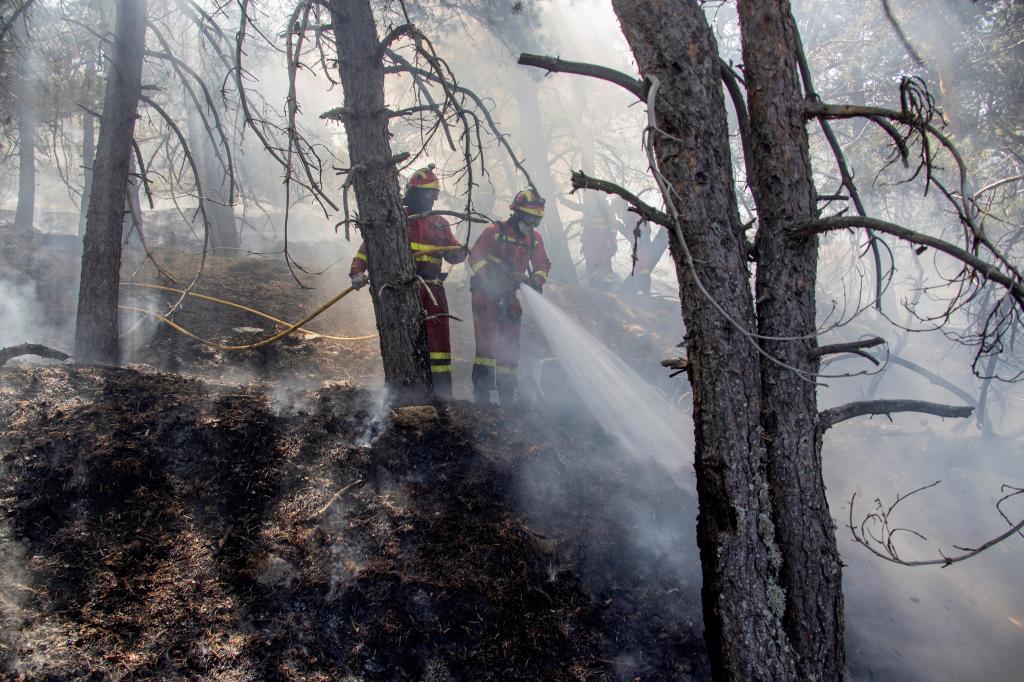One of the most unknown participations in firefighting operations, but not least, is that of the forest agents' body. Its mission is to provide information on a land that they know perfectly, indicate where the most dangerous tracks, roads or forest masses are, but above all, expose the main environmental values that must be strategically protected.
The flames of the last fire of Miraflores de la Sierra threatened two populations of very sensitive and endangered animals , the highest category of protection that exists in Spain.
Specifically, it was the black vulture and the only population in the entire community of Madrid of podisma folderna , a very special grasshopper, which was believed extinct and was rediscovered five years ago by the foresters themselves.
Although the decree regulating the extinction of forest fires in the Community of Madrid prioritizes the salvation of people and property, in this case, since there are no nearby urban centers, the operation could focus on protecting these species .
«We prepared the information, passed it to the head of the extinction operation and studied how the fire evolved. Finally, we managed to stop one of the flanks that threatened the species that most worried us, ”explains Miguel Higueras, head of the Forest Agents Corps Operational Service.
One of the species with the greatest problems was the binder podisma. «It is a very sensitive population, especially for its few copies . Any impact seriously affects you. If the fire had arrived, it would have been completely extinguished in Madrid, ”he explains. «The problem is that there is a lot of ignorance, we are still evaluating the real population size. However, the main population centers of this invertebrate have been saved from fire, ”he adds.
The black vulture area had some added complications . This bird, which lays its nests only in two areas of Madrid, Rascafría and the West of the community - the latter very decimated after previous fires - is in breeding season, unlike imperial eagles or storks, which do so before.
Also, when one of their nests burns, they never return to that area. The work of firefighters and forest agents redirected the flanks of the fire avoiding this situation.
The rest of the species that inhabit the area, such as the eagle, the black kite, the rock lizard or the mountain, have suffered severe impacts on their populations, but do not worry forest agents about the existence of habitat in the surroundings and Its high number of copies.
Another one of the problems, not so immediate, derived from the fires with respect to the populations of fauna, and that fight the forest agents, is the burning of the habitats and the vegetation, because they can cause problems for the species to stay in the future or force displacements of them.
The balance of devastated areas in this area is also positive for forestry agents. "Most of the burned is mostly piornal - a small bush - and grassland," explains Higueras. This type of vegetation is easily regenerated and for the forester "it is very likely that in two years it will be as before the fire". However, without his performance, "the area of pine trees where the vultures inhabit could have been burned, which would have been a big problem."
Firefighters and foresters, therefore, consider the operation "a success" and are "happy with the salvation of the most vulnerable species , " in the words of Higueras. «We have preserved the main environmental value».
According to the criteria of The Trust Project
Know more- Madrid
- Spain
- natura
Two fires in Miraflores and Segovia raise the alert to level 1: "Go for long, the wind is the worst enemy"
Spain The fire of Sotillo de Adrada (Ávila) reaches the Iruelas Valley Nature Reserve
Digitization: Nadia Calviño: "The Government does not rule out the Google rate"

